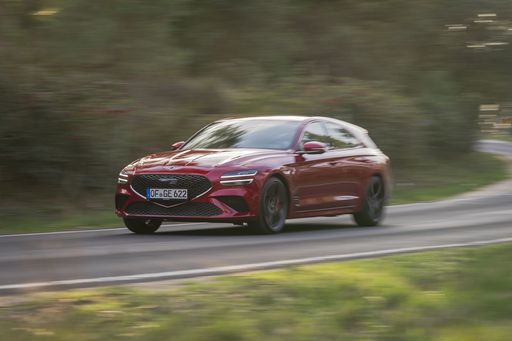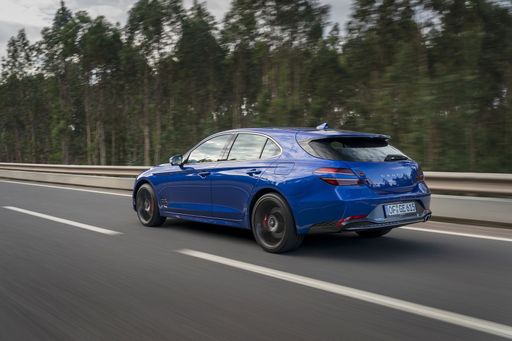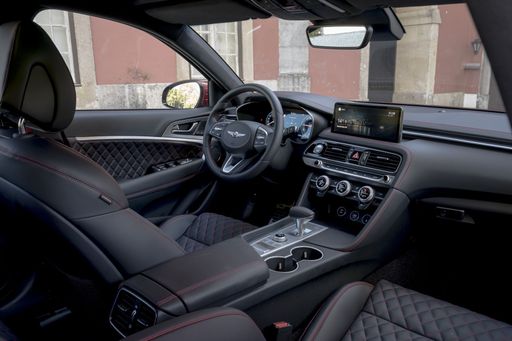Renault Trafic Bus VS Genesis G70 Shooting Brake – Specs, Efficiency & Price Comparison
Find out now which car fits your needs better!
The Renault Trafic Bus (Bus) is powered by a Diesel engine and comes with a Manuel transmission. In comparison, the Genesis G70 Shooting Brake (Estate) features a Petrol or Diesel engine and a Automatic gearbox.
When it comes to boot capacity, the Renault Trafic Bus offers , while the Genesis G70 Shooting Brake provides 465 L – depending on what matters most to you. If you’re looking for more power, you’ll need to decide whether the 150 HP of the Renault Trafic Bus or the 245 HP of the Genesis G70 Shooting Brake suits your needs better.
There are also differences in efficiency: 6.80 L vs 6.90 L. In terms of price, the Renault Trafic Bus starts at 38200 £, while the Genesis G70 Shooting Brake is available from 39600 £.
Compare all the key specs now and find out which model fits your lifestyle best!
Renault Trafic Bus
The Renault Trafic Bus is a versatile and spacious option for those needing to transport multiple passengers comfortably. With its modern design and practical features, it is well-suited for both business and leisure purposes. Its efficient engine and smooth handling make it a reliable choice for long journeys.
detailsGenesis G70 Shooting Brake
The G70 Shooting Brake combines elegance and versatility, offering a sleek design that captivates both style enthusiasts and practical drivers. Its spacious interior and refined craftsmanship make every journey a luxurious experience, while the dynamic performance ensures it delivers excitement on the road. With its unique blend of sporty aesthetics and functional features, the G70 Shooting Brake stands out as a remarkable addition to the automotive landscape.
details @ Genesis
@ Genesis
 @ Genesis
@ Genesis
 @ Genesis
@ Genesis

|
|
|
|
|
Costs and Consumption |
|
|---|---|
|
Price
38200 - 51100 £
|
Price
39600 - 45500 £
|
|
Consumption L/100km
6.8 - 7.2 L
|
Consumption L/100km
6.9 - 9.3 L
|
|
Consumption kWh/100km
-
|
Consumption kWh/100km
-
|
|
Electric Range
-
|
Electric Range
-
|
|
Battery Capacity
-
|
Battery Capacity
-
|
|
co2
179 - 188 g/km
|
co2
180 - 212 g/km
|
|
Fuel tank capacity
80 L
|
Fuel tank capacity
60 L
|
Dimensions and Body |
|
|---|---|
|
Body Type
Bus
|
Body Type
Estate
|
|
Seats
8 - 9
|
Seats
5
|
|
Doors
4
|
Doors
5
|
|
Curb weight
2031 - 2321 kg
|
Curb weight
1727 - 1897 kg
|
|
Trunk capacity
-
|
Trunk capacity
465 L
|
|
Length
5080 - 5480 mm
|
Length
4685 mm
|
|
Width
1956 mm
|
Width
1850 mm
|
|
Height
1973 - 1974 mm
|
Height
1400 mm
|
|
Payload
749 - 982 kg
|
Payload
438 - 448 kg
|
Engine and Performance |
|
|---|---|
|
Engine Type
Diesel
|
Engine Type
Petrol, Diesel
|
|
Transmission
Manuel
|
Transmission
Automatic
|
|
Transmission Detail
Schaltgetriebe
|
Transmission Detail
Automatikgetriebe
|
|
Drive Type
Front-Wheel Drive
|
Drive Type
Rear-Wheel Drive, All-Wheel Drive
|
|
Power HP
110 - 150 HP
|
Power HP
200 - 245 HP
|
|
Acceleration 0-100km/h
13.6 - 16.5 s
|
Acceleration 0-100km/h
6.4 - 8.2 s
|
|
Max Speed
161 - 174 km/h
|
Max Speed
225 - 235 km/h
|
|
Torque
300 - 350 Nm
|
Torque
353 - 440 Nm
|
|
Number of Cylinders
4
|
Number of Cylinders
4
|
|
Power kW
81 - 110 kW
|
Power kW
147 - 180 kW
|
|
Engine capacity
1997 cm3
|
Engine capacity
1998 - 2199 cm3
|
General |
|
|---|---|
|
Model Year
2023 - 2024
|
Model Year
2021 - 2023
|
|
CO2 Efficiency Class
G
|
CO2 Efficiency Class
G
|
|
Brand
Renault
|
Brand
Genesis
|
Renault Trafic Bus
A Glimpse into the Renault Trafic Bus: An Icon of Versatility and Innovation
Amongst the plethora of vans designed for both business and leisure, the Renault Trafic Bus stands out as an exemplar of functionality, innovation, and style. Let's delve into what makes the Renault Trafic Bus a popular choice in the UK and across Europe, particularly focusing on its technical specifications and state-of-the-art features.
Performance Dynamics: Power Under the Hood
The Renault Trafic Bus, a staple in Renault's fleet, is driven by a robust diesel engine configuration with power outputs ranging from 110 PS to a formidable 170 PS. The diesel engines combine efficiency and power, offering torque figures between 300 to 380 Nm, ensuring smooth power delivery and capable load hauling.
Drivers can choose between manual and automatic transmissions, both designed to complement the Trafic's front-wheel-drive system. This flexibility ensures that drivers experience enhanced driving comfort whether they are navigating urban roads or cruising on the motorway.
Efficiency Meets Economy
The Trafic Bus showcases impressive fuel economy with consumption figures ranging from 6.8 to 7.2 litres per 100 kilometres. This efficiency is crucial for businesses aiming to minimise operational costs and for families seeking budget-friendly travel options.
With a generous fuel tank capacity of 80 litres, the Renault Trafic Bus is built to cover long distances with fewer fuel stops, making it an ideal choice for long haul journeys.
Technological Innovations and Comfort
The Trafic Bus isn't just about robust performance. Renault has integrated a suite of technological innovations designed to enhance driver and passenger comfort. Its cabins are equipped with the latest infotainment systems and safety technologies, providing an optimal blend of comfort and convenience.
The various trims, such as Life, Start, Spaceclass, and their respective EDC variants, cater to different needs and preferences, ensuring that customers can find the perfect configuration for their requirements.
Design and Dimensions: Space for Every Purpose
Space and versatility are at the heart of the Trafic Bus design. With its dimensions ranging from a length of 5080 to 5480 mm, and a width of 1956 mm, this vehicle offers ample room for passengers and cargo alike. The height stands between 1973 and 1974 mm, ensuring that even taller individuals can travel comfortably.
With seating for up to eight people and a payload capacity between 730 to 1010 kg, the Trafic Bus can transform seamlessly between a people-mover and a goods carrier.
Environmental Considerations
Renault has engineered the Trafic Bus with environmental responsibility in mind. The CO2 emissions range from 178 to 190 g/km, which, while modest for its class, aligns with the efficiency and performance goals set for this versatile vehicle. The CO2 efficiency class is rated as 'G', offering transparency in its environmental impact profile.
Conclusion: A Leader in Its Class
The Renault Trafic Bus continues to lead its segment through a blend of power, efficiency, and technological advancements. Whether it's for commercial transport or family adventures, the Trafic offers a reliable and adaptable solution, setting a high standard for multi-purpose vehicles.
For those seeking a distinguished blend of utility and comfort, the Renault Trafic Bus emerges as an exceptional choice, promising performance and innovation on every journey.
Genesis G70 Shooting Brake
Discovering the Genesis G70 Shooting Brake: A New Era of Luxury and Performance
The Genesis G70 Shooting Brake enters the market as an exciting blend of aesthetics, practicality, and high-end performance. With its sleek wagon design, this model encapsulates the spirit of a luxury sports vehicle while offering exceptional utility. As a new variant of the popular G70 lineup, the Shooting Brake brings with it innovative technological advancements and a range of powerful engine options tailored to meet the demands of the modern driver.
Engine Options and Performance
The G70 Shooting Brake offers a selection of impressive powertrains, designed to cater to diverse preferences. Buyers can choose between robust petrol engines and fuel-efficient diesel variants. The petrol engine lineup features a 2.0T powerhouse that delivers an exhilarating 245 HP through both rear-wheel and all-wheel drive configurations, providing swift acceleration from 0 to 100 km/h in just 6.4 seconds.
On the diesel front, the 2.2D engine produces 200 HP, showcasing an exemplary balance of performance and efficiency, achieving a commendable fuel consumption as low as 6.9 L/100 km. This engine also allows for competitive acceleration and excellent torque output, making the G70 Shooting Brake not just a stylish choice but a practical one as well.
Innovative Features and Technology
In keeping with the Genesis ethos of luxury and innovation, the G70 Shooting Brake is replete with advanced technology that enhances the driving experience. The interior is adorned with high-quality materials and state-of-the-art infotainment systems that ensure both comfort and connectivity. A standard touch screen interface allows for seamless integration with navigation and entertainment systems, while available premium audio options elevate the overall atmosphere inside the vehicle.
Safety is also a priority, with multiple driver assistance features such as adaptive cruise control, lane-keeping assist, and automatic emergency braking. These systems work in harmony to provide a reassuring driving experience, particularly in busy urban environments or during long-distance journeys.
Design and Practicality
The aesthetic appeal of the G70 Shooting Brake is evident in its sleek silhouette and dynamic proportions. With a length of 4,685 mm and a height of 1,400 mm, its design strikes a perfect balance between sportiness and practicality. The spacious trunk capacity of 465 liters makes it a versatile option for those who value cargo space without compromising luxury.
Attention to detail can be found throughout the cabin, with ample space for five passengers, ensuring everyone enjoys a comfortable ride. The thoughtful layout and high-end materials foster an inviting environment that echoes the Genesis commitment to excellence.
Pricing and Availability
The Genesis G70 Shooting Brake is positioned in the luxury market with a competitive price range starting at approximately €48,080 for the base model, and reaching up to €53,080 for fully-loaded variants. Given its blend of performance, luxury, and practicality, the G70 Shooting Brake presents a compelling proposition for buyers seeking a premium vehicle that doesn't shy away from a sporty edge.
Conclusion
The Genesis G70 Shooting Brake is more than just a car; it represents a lifestyle choice for those who appreciate sophistication and performance in equal measure. With its innovative technology, powerful engine options, and attention to detail, this model is set to redefine the standards within the luxury wagon segment. For anyone looking to elevate their driving experience, the G70 Shooting Brake is a worthy consideration.
The prices and data displayed are estimates based on German list prices and may vary by country. This information is not legally binding.
